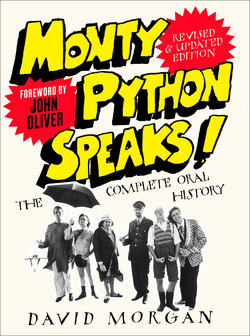Читать книгу Monty Python Speaks! Revised and Updated Edition - David Morgan - Страница 16
ALL BRONTOSAURUSES ARE THIN AT ONE END, MUCH MUCH THICKER IN THE MIDDLE, AND THEN THIN AGAIN AT THE FAR END.
– (MISS) ANNE ELK
ОглавлениеCLEESE: When I was working on The Frost Report I felt quite frustrated – not in a desperate, emotional sense, but held in – by the format of sketches, by the tyranny of the punchline, by the fact that more surreal things would be suggested and all the writers would laugh, and the producer/director Jimmy Gilbert (a man I liked hugely) would smile and be amused himself, and say, ‘Yes, but they won’t understand that in Bradford.’ So we were straining against conventions.
I do know when we sat down for Python that we were convinced we were not going to do something in a conventional format. On At Last the 1948 Show we managed to parody the format without breaking it; in other words, between sketches we would cut to this delightful girl, Aimi MacDonald, and Aimi would say with this extraordinary voice of hers – it was like someone had escaped from a cartoon and had elocution lessons – ‘Well! That was a funny sketch, wasn’t it?’ We were already beginning to play with the form; it was definitely a step towards Python.
I had a gut feeling that the sort of thing we were going to do on Python was all the things that made the writers laugh on The Frost Report but which we weren’t allowed to put on. But of course we didn’t know how, and if you look at Python, the first few are much more conventionally constructed (although to my taste the humour is very, very good; I think a lot of the early stuff is very odd and very funny). And what happened was the material in some cases got rather less funny, but we began to package it more skilfully as we played with the format.
How was the format or shape of the show ultimately decided upon, as it was quite different from what had come before?
JONES: We never really discussed it that much. John, Eric, and Graham weren’t particularly interested in the shape of the show; they were just interested in funny material, making sure the sketches were funny. I was much more concerned – and Terry and Mike also felt a bit more like I did – that we needed to find a new formula, a new format, really. Apart from the sketch material, the earliest meetings were mainly discussions about the name of the show! But I remember I really had this feeling that this was going to be an absolutely crucial time, that we had to get this one right, this is our chance.
So I was thinking quite hard about the shape of the show, and I saw [Spike] Milligan’s Q5, and I thought, ‘Fuck! Milligan’s done it!’ He did a show [where] one sketch would start and drift off into another sketch, things would drift into one another; he made it so clear that we’d been writing in clichés all this time, where we either did three-minute sketches with a beginning, middle, and end, or else we did thirty-second blackouts – one joke with a blackout – so it was still very much the shape of a traditional English revue. Milligan was messing around with this and doing something totally different.
I can just remember walking upstairs at my parents’ home in Claygate and suddenly realizing that Terry Gilliam had done an animation for one of the Do Not Adjust Your Sets called ‘Beware of Elephants’. He’d been a bit diffident about it; he’d say, ‘Well, it’s sort of stream-of-consciousness, one thing leads to another, it’s not really about anything.’ He’d done another one called ‘Christmas Cards’. And so I was going upstairs and I suddenly thought, ‘That’s what we could do: we can do what Milligan’s done with breaking up the sketch format and just do a whole thing that’s stream-of-consciousness, and Terry’s animations can go in and out and link things, and the whole show would just flow like that. And I phoned Mike, I suppose, and Terry G., in great excitement. [They went,] ‘Yeah, yeah, yeah, yeah!’
And then as far as I remember, we put this to the group and they were grumbling: ‘Yeah, all right, well anyway, let’s get on with the sketch.’
So the first series was very much a fight between the Oxford contingent, if you like, trying to push this stream-of-consciousness into the thing, and the Cambridge group. The Cambridge side weren’t particularly interested; they weren’t against it, but they weren’t particularly interested.
IDLE: We had already tried something like this on Do Not Adjust Your Set and also We Have Ways of Making You Laugh with Gilliam. It was the natural way to go. We were essentially avoiding doing anything that was like the shows we had already worked on or were on the Beeb at the time. Cleese was tired of formats, Jonesy the keenest on experimentation – or at least the loudest in praise of it. But Gilliam was keen to experiment and Graham always anxious to push the envelope: ‘Can we make it a little madder?’ he would say.
GILLIAM: My memory of the first meetings was in John’s flat in Basil Street in Knightsbridge. I just remember sitting up in John’s room a lot and talking and arguing. I think by loosening it up as we did, it then freed us up so that we could have everybody write what they wanted to do, and then we start filtering it through the group’s reaction to the stuff.
